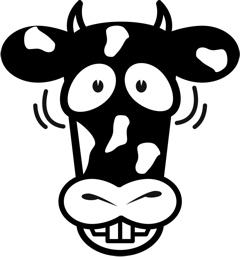A magazine where the digital world meets the real world.
On the web
- Home
- Browse by date
- Browse by topic
- Enter the maze
- Follow our blog
- Follow us on Twitter
- Resources for teachers
- Subscribe
In print
What is cs4fn?
- About us
- Contact us
- Partners
- Privacy and cookies
- Copyright and contributions
- Links to other fun sites
- Complete our questionnaire, give us feedback
Search:
The Devil is in the Detail: Lessons from Animal Welfare?

What can computer Scientists learn from a remarkable woman and the improvements she made to animal welfare and the meat processing industry?
Temple Grandin is an animal scientist - an animal welfare specialist and a remarkable innovator on top. She has extraordinary abilities that allow her to understand animals in ways others can't. As a result her work has reduced the suffering of countless farm animals. She has designed equipment, for example, to restrain animals. It makes it easier to give them shots because, in contrast to the equipment it replaces, it does not discomfort the animals as they enter. By being able to see the detail that an animal perceives she is able to design to overcome the problems. Paradoxically perhaps for someone who cares so much about animals, she works with slaughter houses - Meat Processing factories like those of McDonalds.
Her aim, given people do eat meat, is to ensure the animals are treated humanely throughout the process of rearing an animal until its death. Her work has been close to miraculous in the changes she has brought about to ensure that farm animals do not suffer. She is good for business too. If cattle are spooked by something as they enter the processing factory, whether by the glint of metal or a deep shadow, the plant's efficiency drops. Fewer animals are processed per hour and that is a big problem for managers.
As a result of her work she has turned round plants, both in welfare terms and in terms of rescuing plants that might otherwise have been shut down. Suddenly plants she audits are treating their livestock humanely.
See the Bigger Picture
Where do Temple's extraordinary abilities come from? In fact she was originally labelled as being mentally disabled. She is actually autistic. As a result her brain doesn't quite work the way most people's do. Autistic people as a result of these brain differences often have difficulties socialising with others. They can find it very hard to understand the nuances of human-human communication that the rest of us take for granted. This is in part because autistic people perceive the world differently. A non-autistic person misses vast amounts of the detail in front of their eyes. Instead just a bigger picture of what they are seeing is passed to their conscious selves. An autistic person doesn't have that sub-conscious ability to filter out detail, but instead perceives every small thing all at once. That is why autistics can sometimes be overcome by their surroundings, finding the world too much to cope with. They think in terms of a series of pictures full of detail, not abstractly in words.
Temple Grandin argues that that is what makes her special when it comes to understanding farm animals. In some ways they see the world very much like she does. Just as a cow does, she notices the shadows and the glint of metal, the bright patch on the floor from the overhead lights or the jacket laid over the fence that is spooking it. The plant managers and animal handlers don't even register them never mind see them as a problem.
Who ya gonna call?
Because of this ability to quickly spot the problems everyone else has missed, Temple gained a reputation for being the person to call when a problem seemed intractable. She has also turned it into a career as an animal welfare auditor, checking processing plants to ensure their standards are sufficiently high. This is where she has helped force through the biggest improvements, and it all boils down to checklists.
Tick that box
Checking that lists of guidelines are being adhered to is a common way to audit quality in many areas of life. Checklists are used in a computer science context as checks for usability (for example that a new version of some application is easy to use) and accessibility (could a blind person, or for that matter someone who was autistic, successfully use a website say). Checklists tend to be very long. After all it must be the case that the more you are checking, the higher the quality of the result, mustn't it? Surprisingly that turns out not always to be true! That is why Temple Grandin has been so successful. Rather than have a checklist with hundreds of things to check she boiled her own set of questions to ask down to just 10.
Traditional animal welfare audits have checklist questions such as "Is the flooring slippery?" and "Is the electric prod used as little as possible?". Even apart from the number to work through this kind of checklist can be very hard to follow, not least due to the vagueness.
Ouch!
Temple's checklist includes questions like: "Do all animals remain unconscious after being stunned?", "Do no more than 3% of animals vocalise during handling or stunning?" (a "Moo" in this situation means "Ouch") They are precise, with little room for dispute - it isn't left to the inspectors judgement. That also means everyone knows the target they are working towards. The fact that there are only 10 also means it is easy for everyone involved to know them all well. Perhaps most importantly they do not focus on the state of the factory, or the way things are done. Instead, they focus on the end results - that animals are humanely treated. The point is that one item covers a multitude of sins that could be causing it. If too many animals are crying out in pain then you have to fix ALL the causes, even if it is something new that no-one thought of putting on a checklist before.
Temple's 10 point approach to checklists can apply to more than just animal welfare of course. The principles behind it could just as well apply to other areas like usability and accessibility of websites.

Some usability evaluation techniques do follow similar principles. Cognitive Walkthrough, a method of auditing that systems are easy to use on first encounter, has some of the features of this kind of approach. The original version involved a longish set of questions that an expert was to ask him/herself about a system under evaluation. After early trials the developers of the method Cathleen Wharton, John Rieman, Clayton Lewis and Peter Polson quickly realised this wasn't very practical and replaced it by a 4 question version. It has since then even been replaced by a 3-question walkthrough. One of the questions, to be asked of each step in achieving a task, is: "Will a user know what to try and do at this point?" This has some of the flavour of the Grandin approach - it is about the end result not about some specific thing going wrong.
Let's look at accessibility. Currently, where web designers think about it at all (UK law requires them to) the long checklist approach tends to be followed. Typical items to check are things like "Ensure that all information conveyed with colour is also available without colour". Automatic systems are often used to do audits. That is good in one sense as the criteria have then to be very precise for a mere computer to make the decision. On the other hand it encourages items in the checklist to just be things a computer can check. It also encourages the long list of fine detail approach that Temple rejected. Worse, it also can lead to people conforming to the checklist without deeply understanding what the point actually is. A classic example is a web designer adding as the last item on a web page "If you are partially sighted click here". As far as an automatic checker is concerned they may have done everything right - even providing alternative facilities that are clearly available (if you can see them). A partially sighted person however would only get to that instruction on the screen after they have struggled through the rest of the page. The designer got the right idea but missed the point.
Temple Grandin's approach would suggest instead having checklists that ask about the outcomes of using the page: "Do 97% of partially-sighted people successfully complete their objective in using the site?" for example. That is why "user testing" is so important, at least as one of the evaluation approaches you follow. User testing involves people from a wide variety of backgrounds actually trying using your prototype software or web pages before they are released. It allows you to focus on the big picture. Of course if you are trying to ensure a web page is accessible your users must include people with different kinds of disabilities.
The Big Picture
One of Temple Grandin's main messages is that the big advantage that arises as a result of her autism is that she thinks in concrete pictures not in abstract words. Whilst thinking verbally is good in some situations it seems to make us treat small things as though they were just as important as the big issues.
So whatever you are doing, whether looking after animals or designing accessible websites, don't get lost in the detail. Focus on the point of it all.
Further Reading
Animals in Translation. Temple Grandin and Catherine Johnson, Bloomsbury, 2005.


